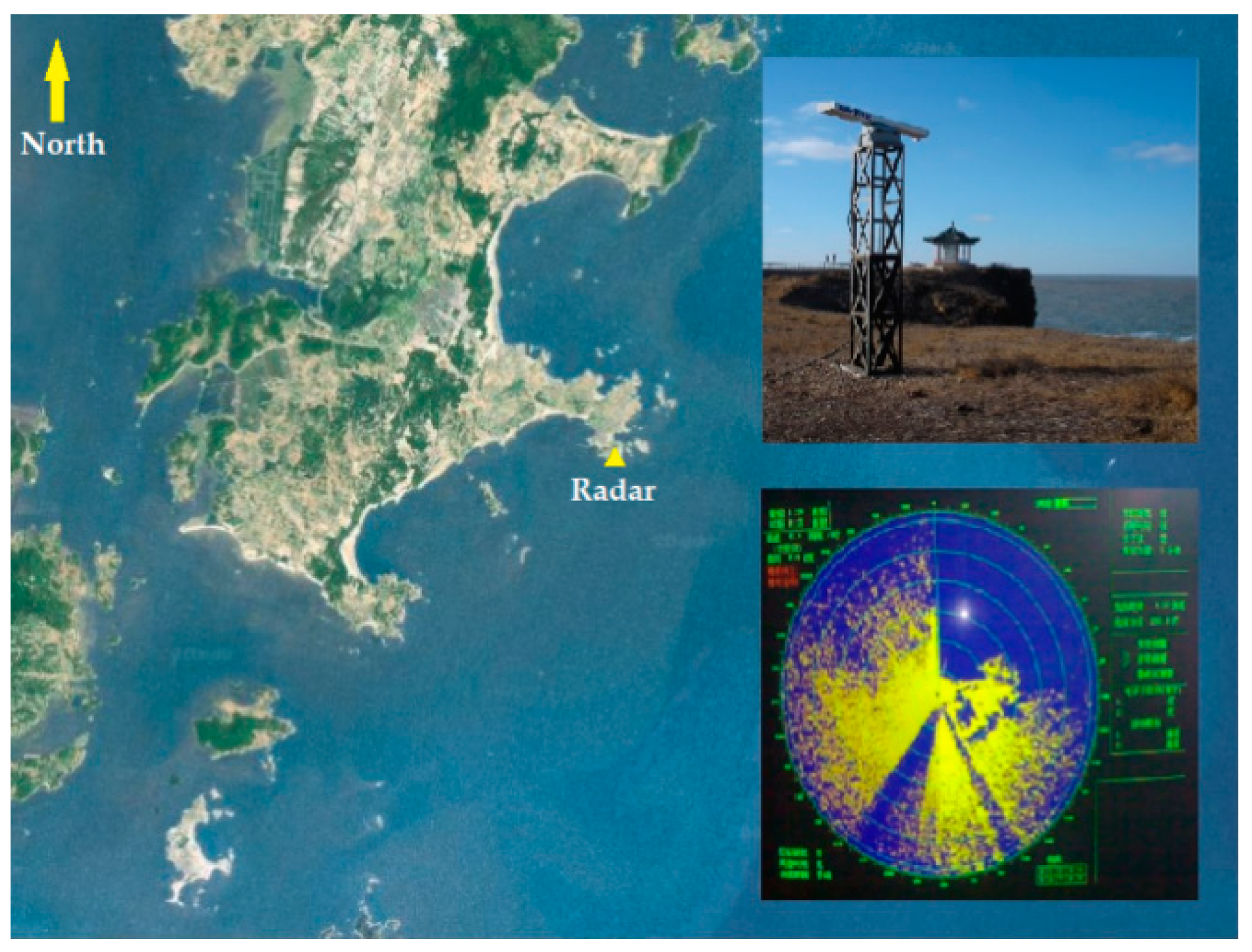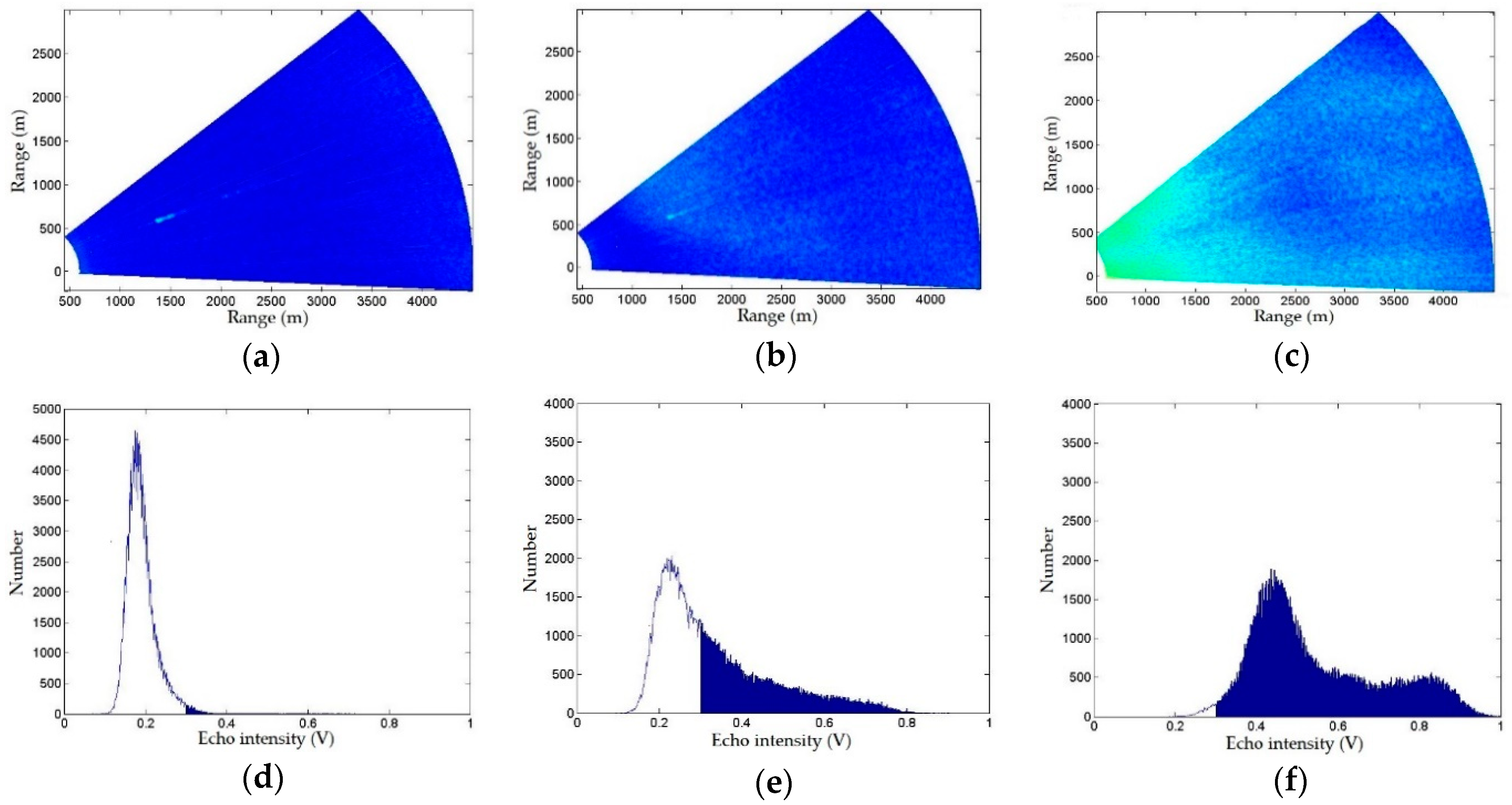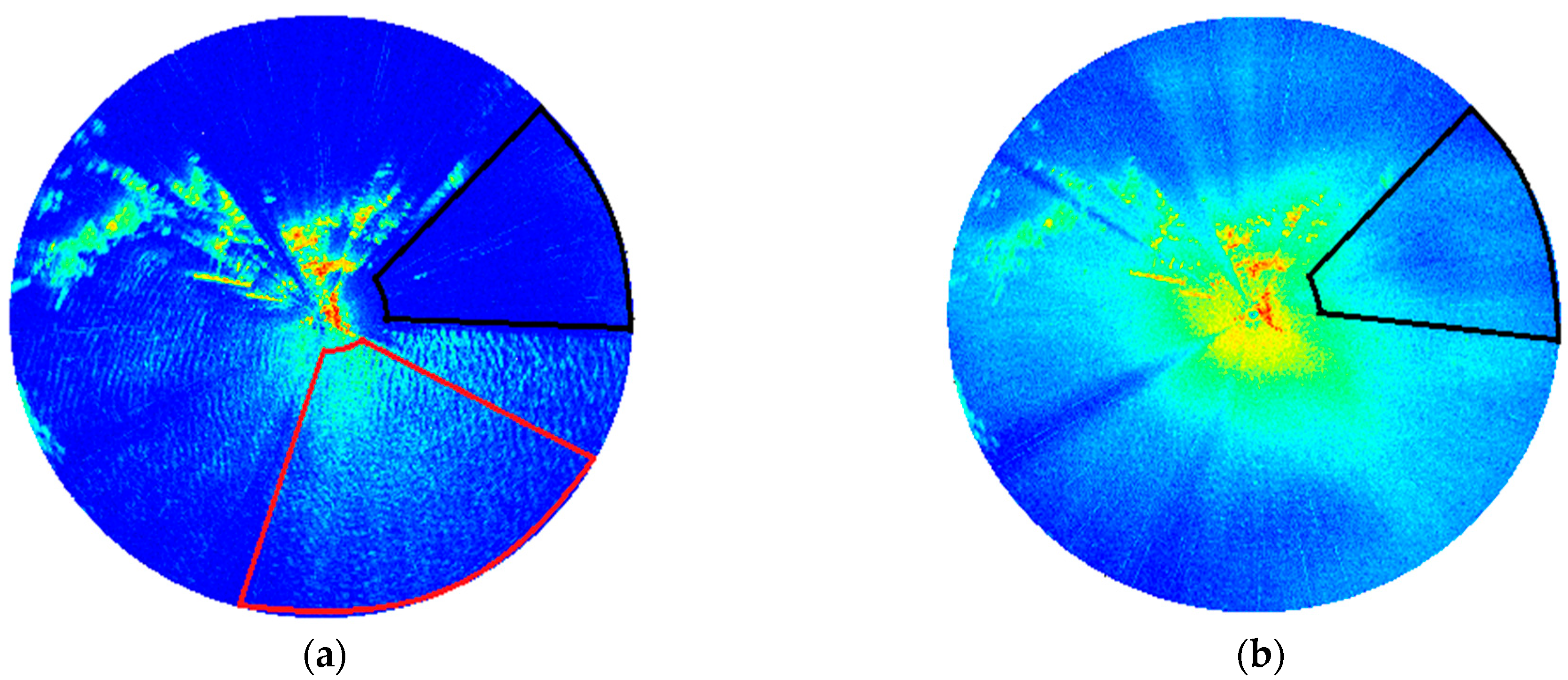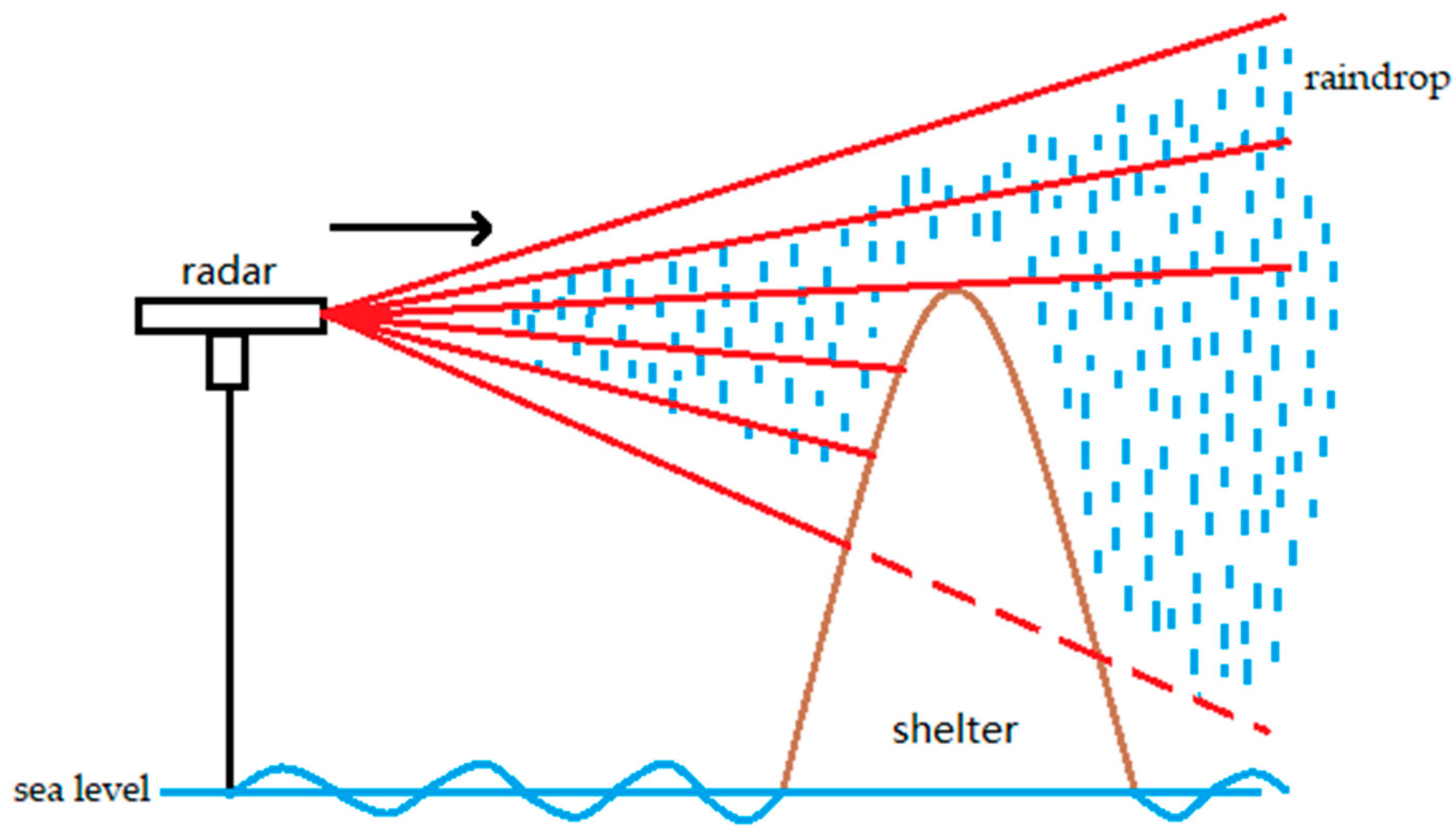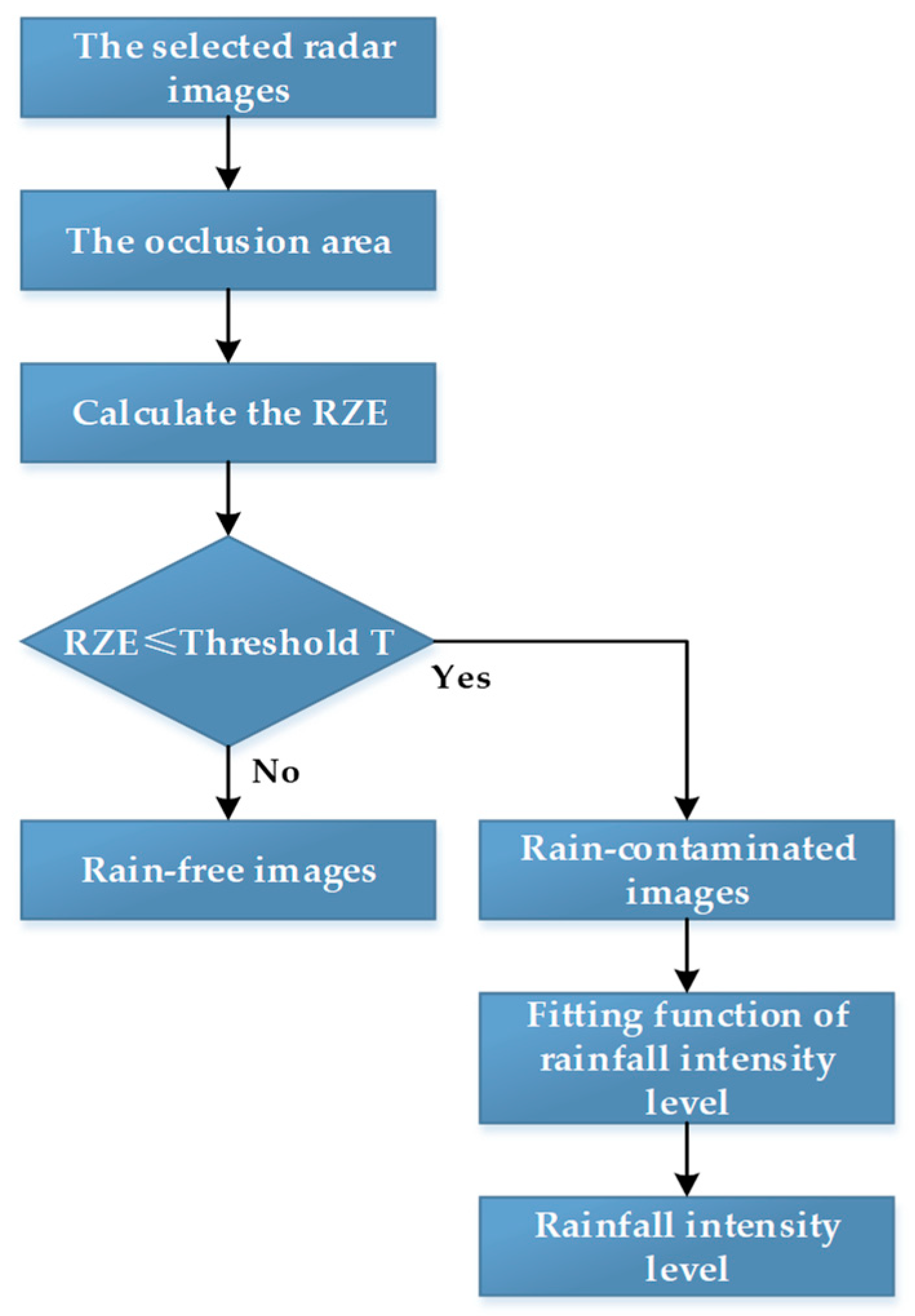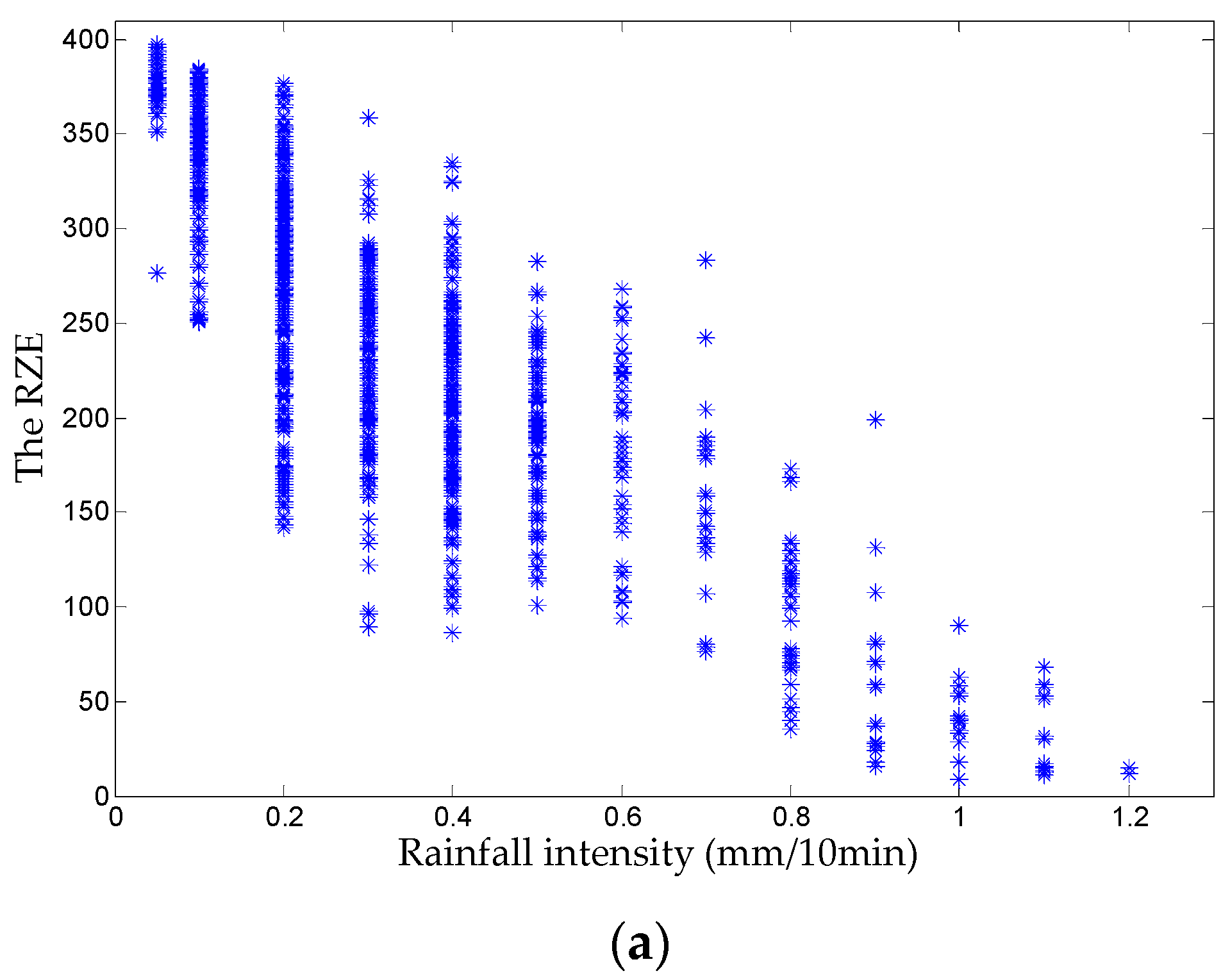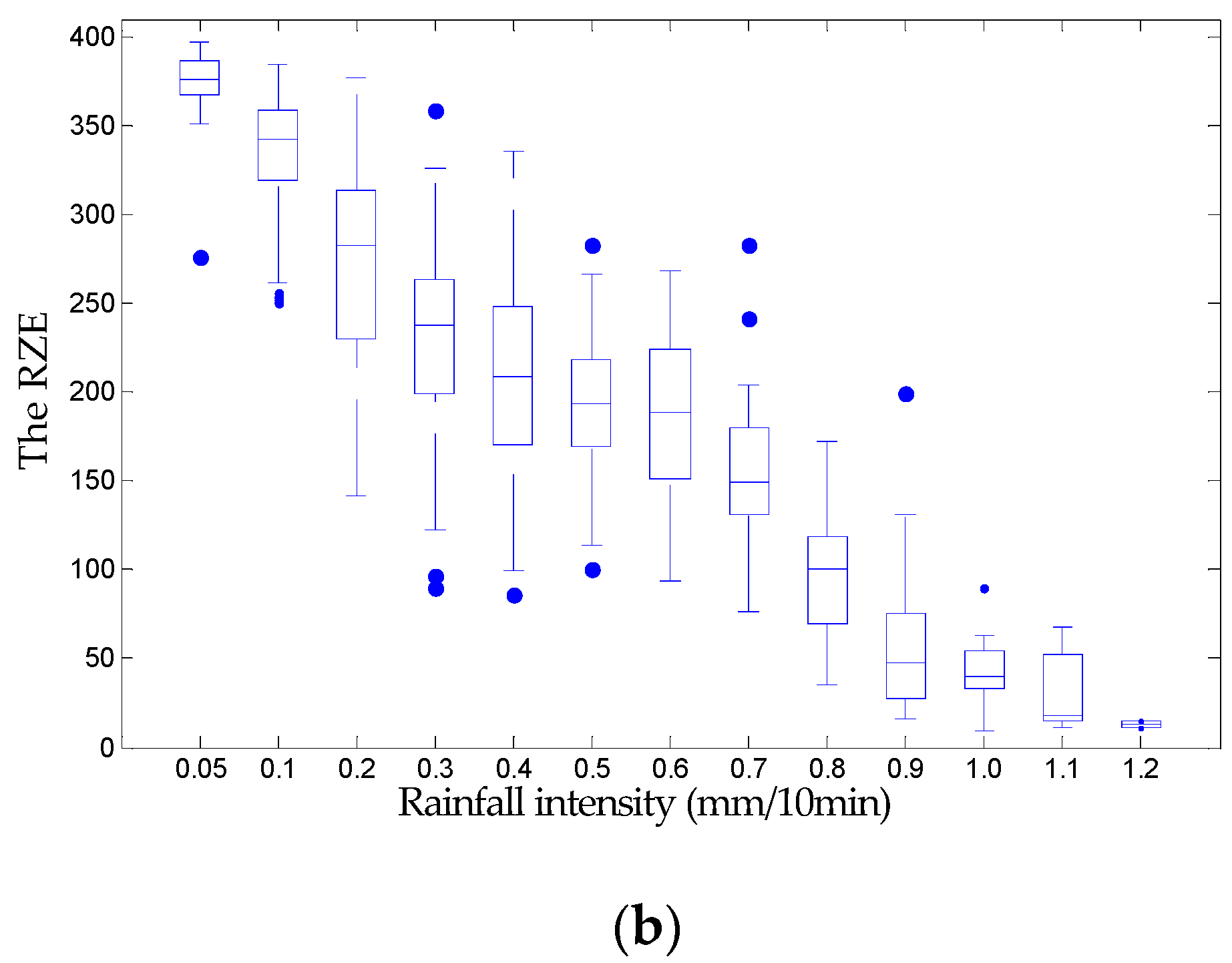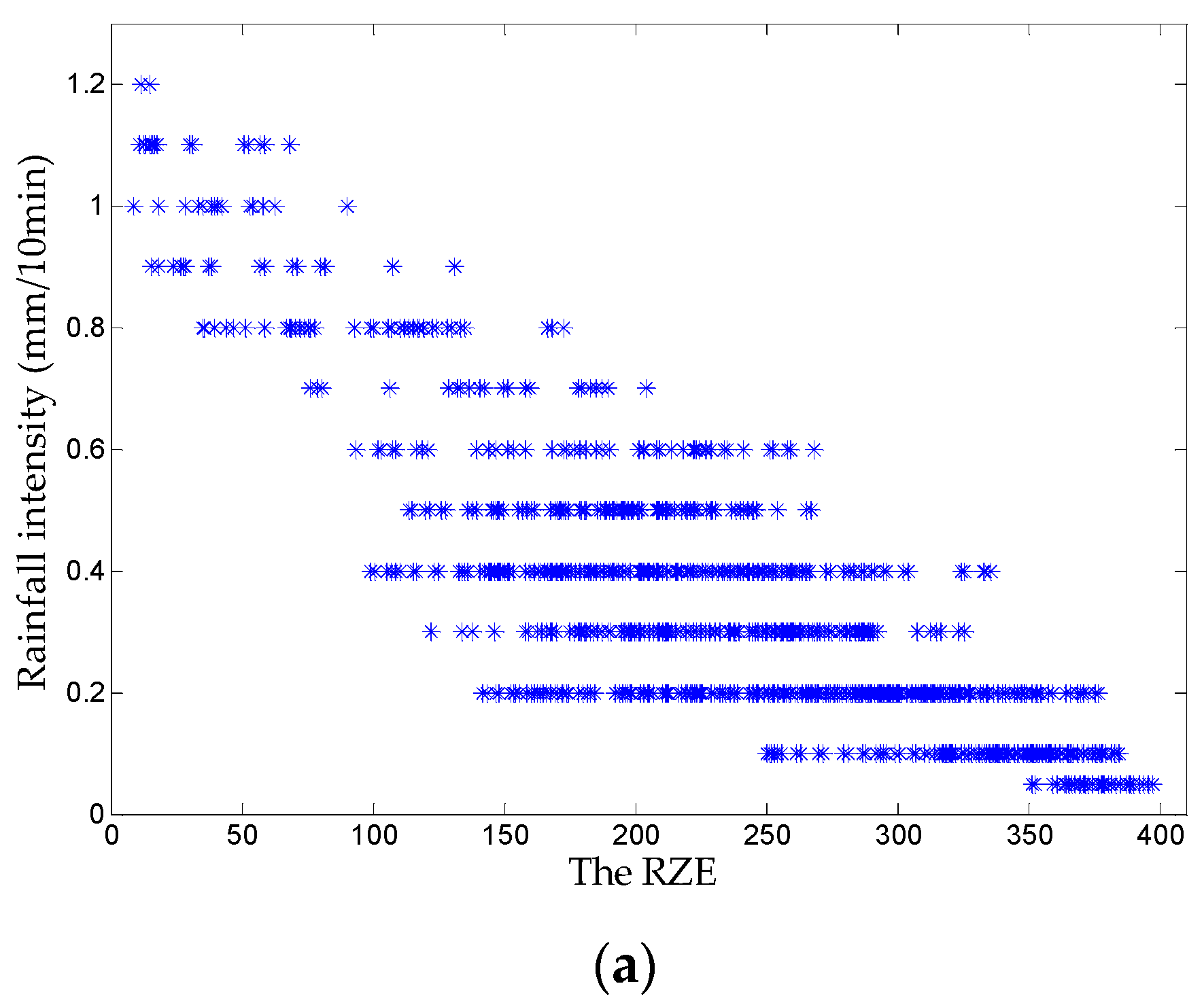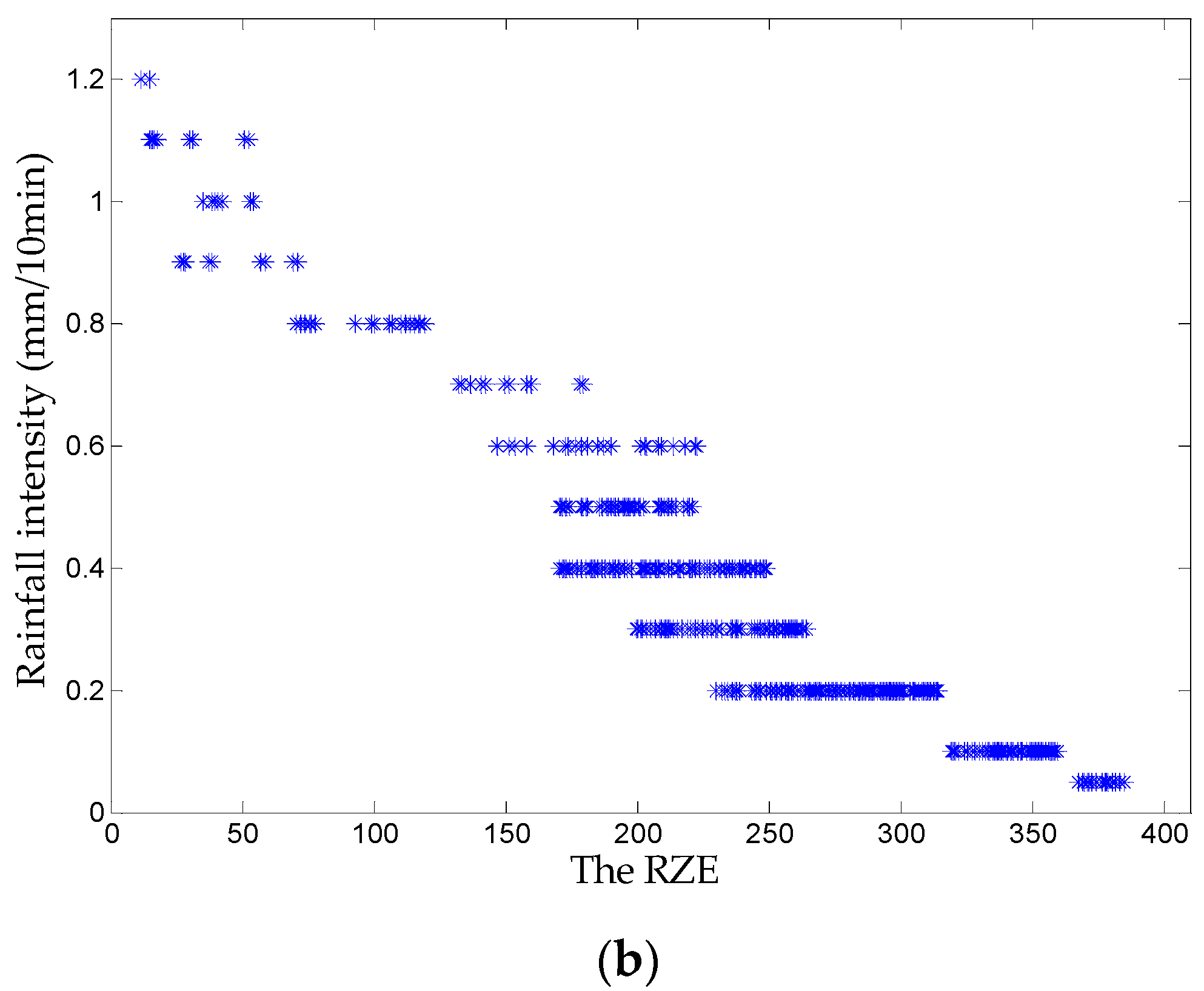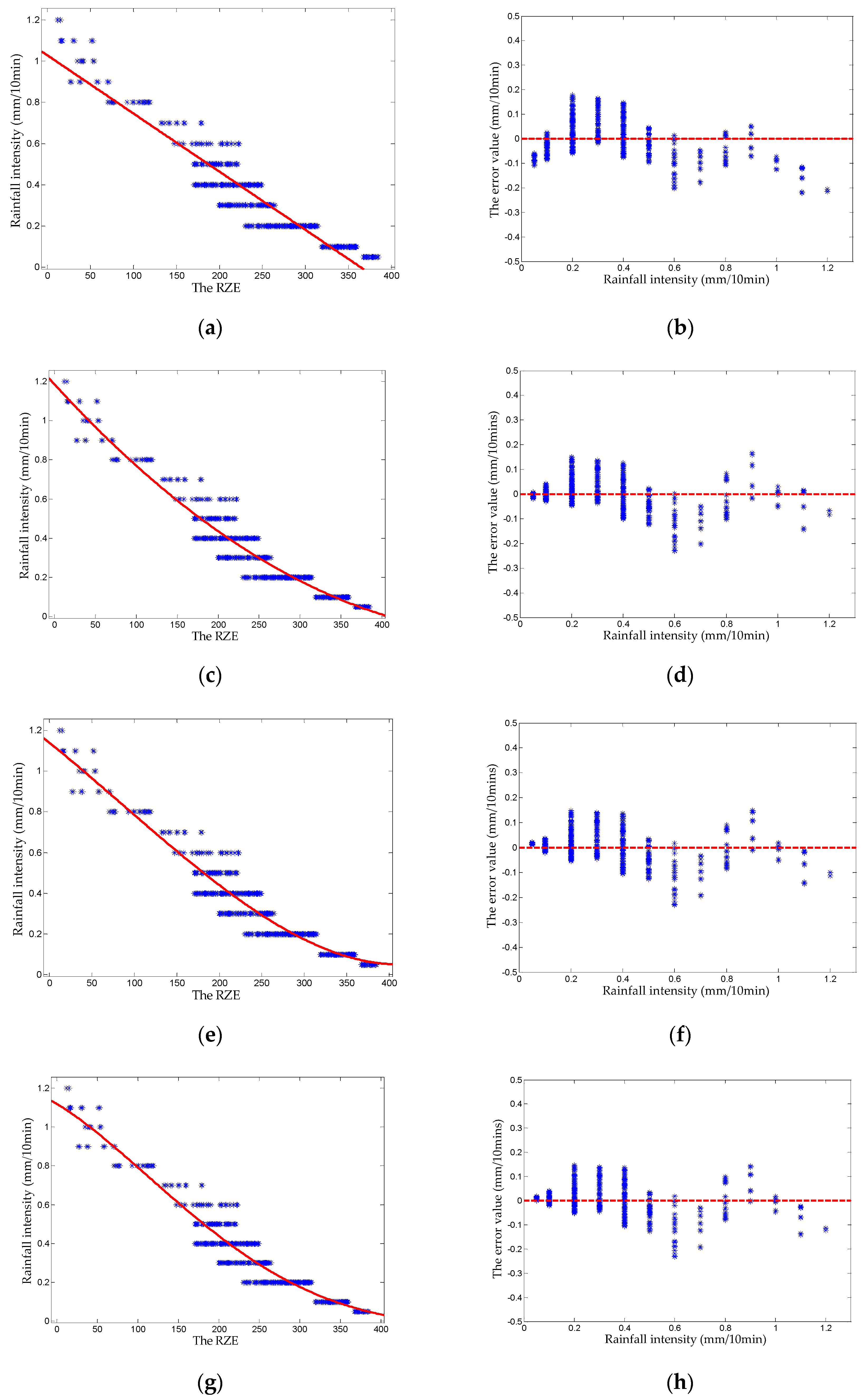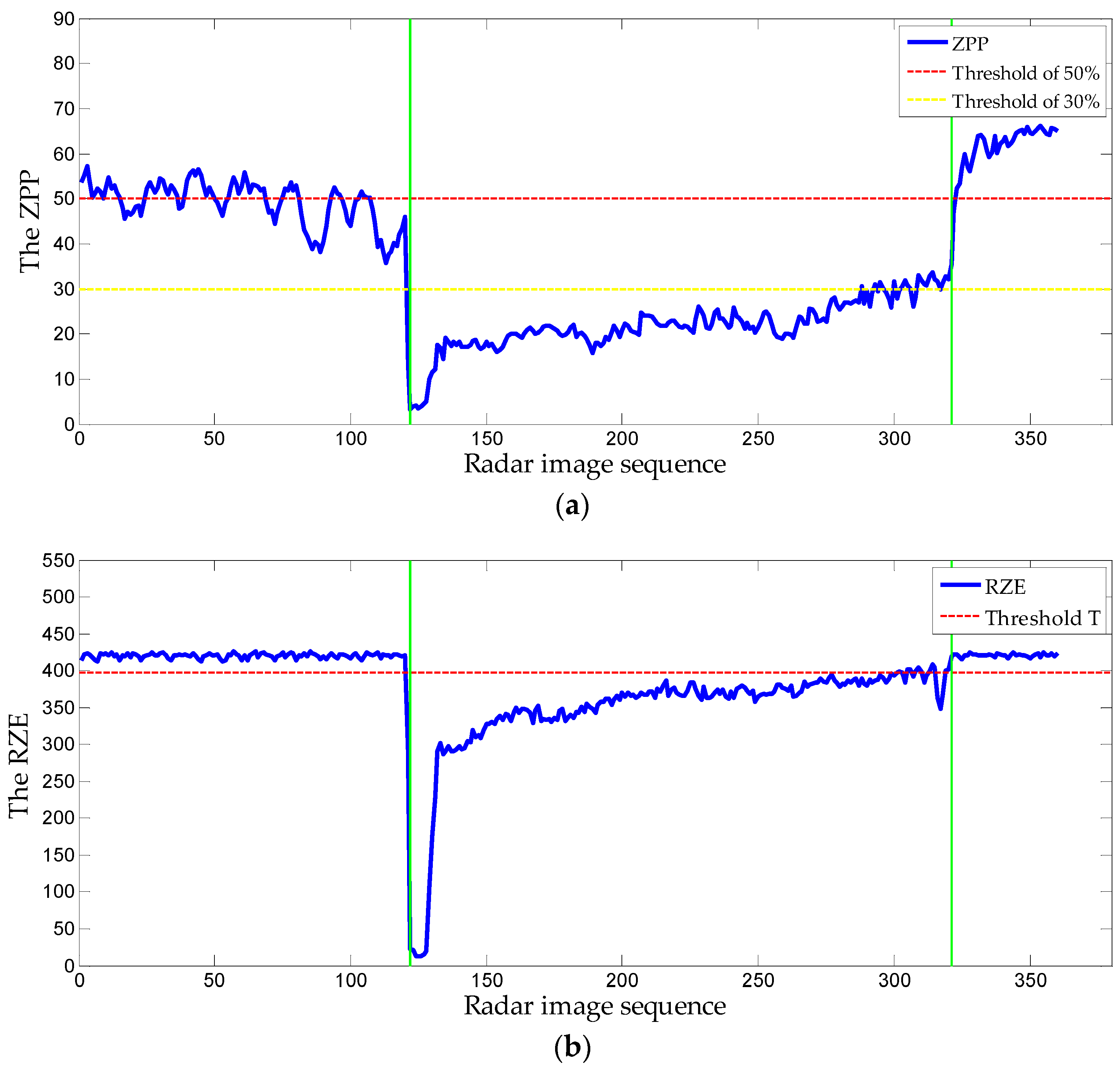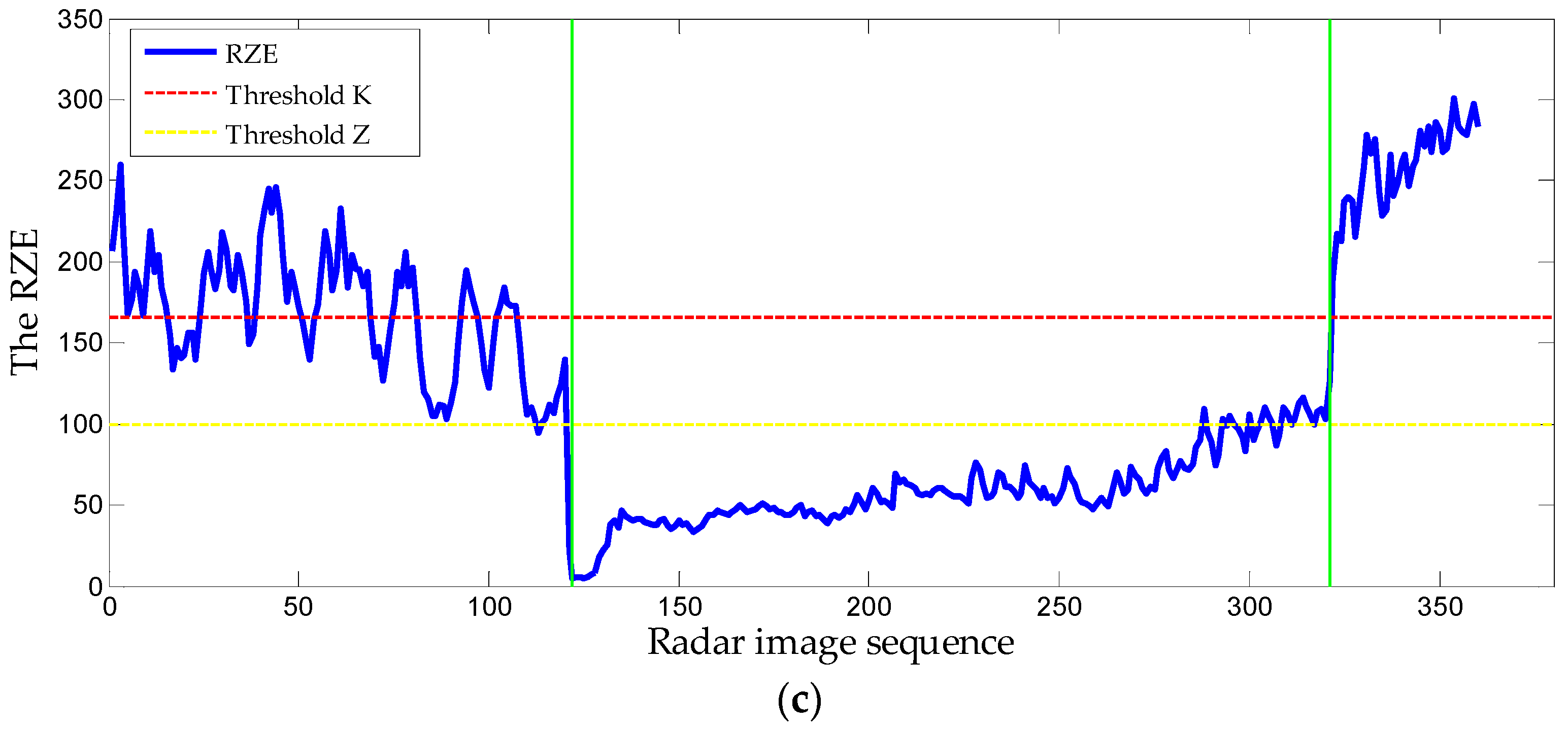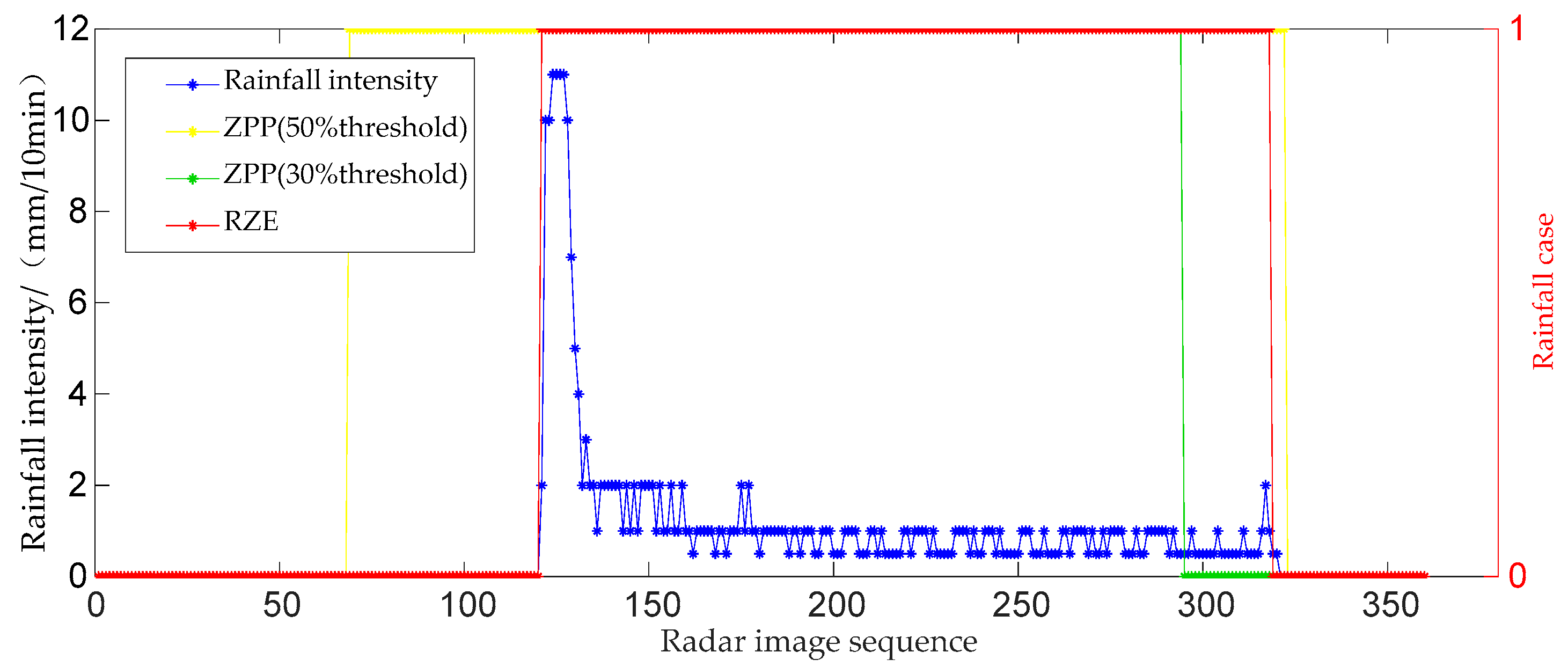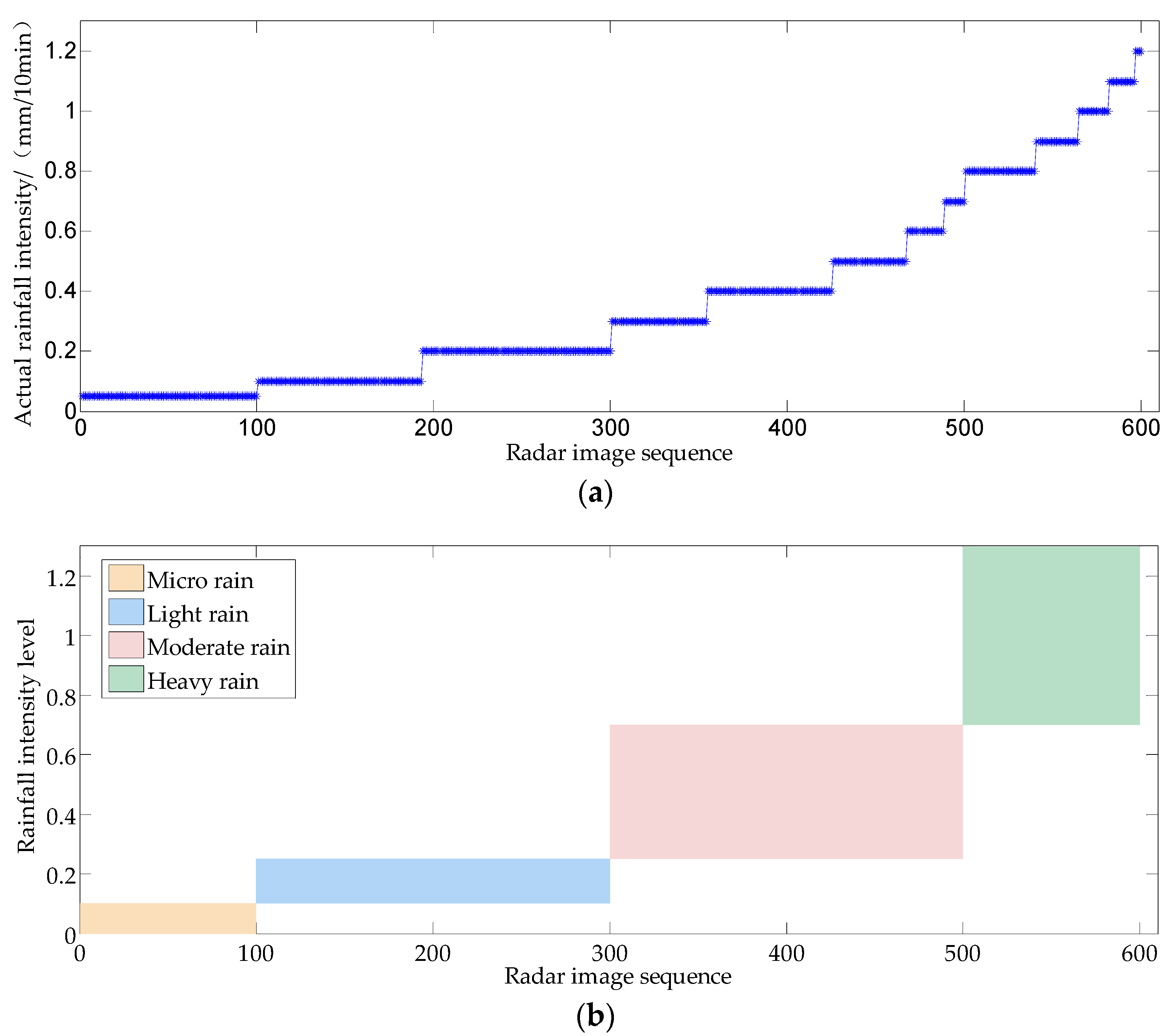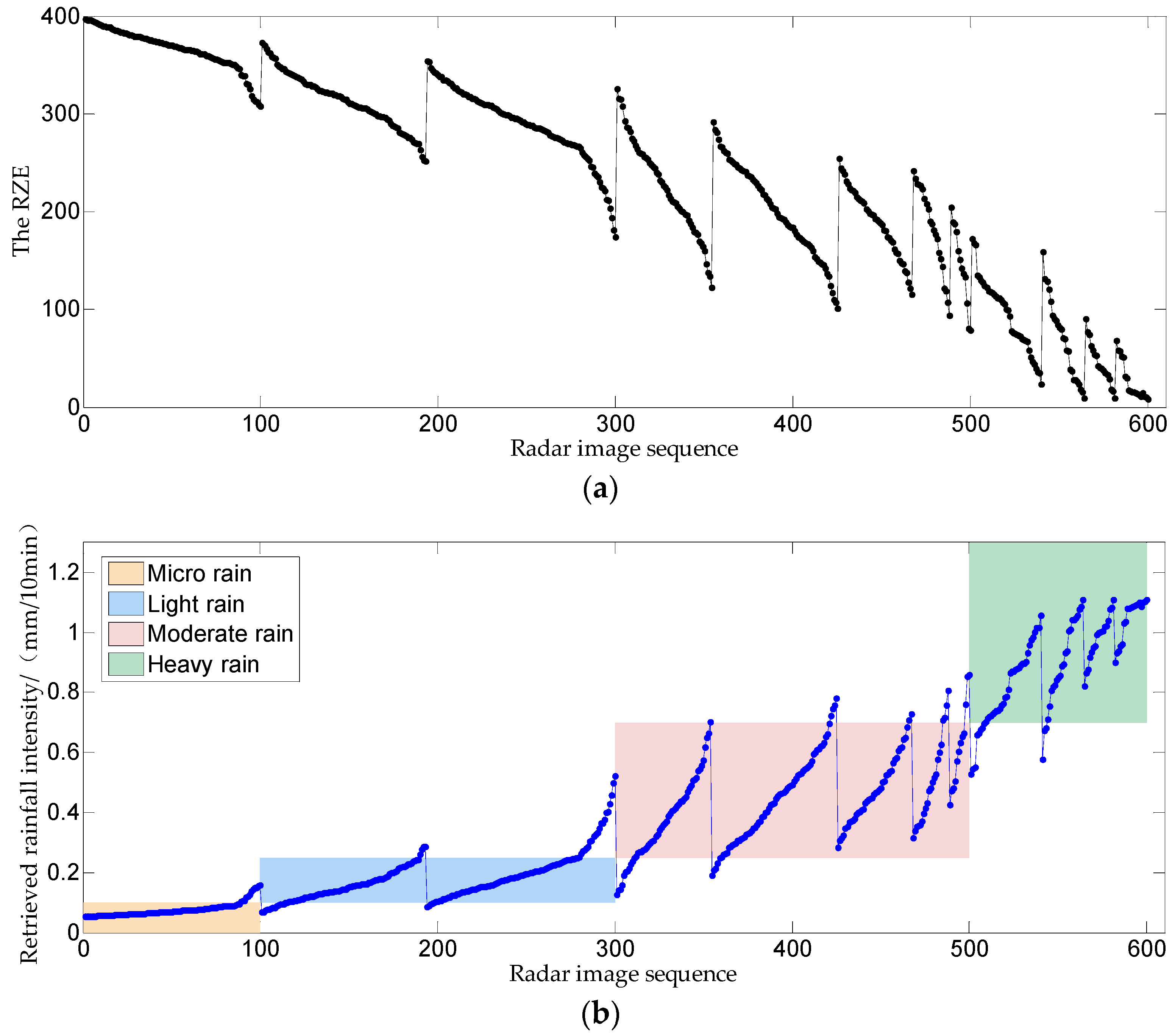1. Introduction
The observation and exploration of the ocean have many significances in the utilization of marine resources, the safety of ship navigation, and the construction of shore ports. Through the high-resolution radar equipment, the wave motion can be observed in real time. The ocean parameters such as wavelength, wave direction, wave height and wave period can be obtained [
1], and the ocean dynamic parameters such as wind, current and wave can be extracted [
2,
3,
4]. In the process of ocean information extraction, many noises affect the extraction accuracy, including co-channel interference, target and rainfall [
5,
6]. Among them, rainfall has the greatest impact on the radar image and seriously interferes with the accurate extraction of ocean wave information [
7]. In order to obtain these data in real time, wave observation equipment and wave inversion method have been studied by researchers.
The existence of rainfall can change the roughness of the ocean surface, which increases the radar backscattering [
8]. The existence of rainfall also increases the attenuation of electromagnetic waves and reduces the measuring range of radar [
9]. In the case of high rainfall intensity, the electromagnetic wave signal is seriously interfered, which seriously affects the extraction of wave parameter information and wind parameter information [
10,
11]. Currently, rainfall in the process of ocean wave retrieval is mostly regarded as interference, and the rain-contaminated radar images are detected, screened and suppressed by algorithms [
12]. Rainfall can also be regarded as the research target, and the information of rainfall intensity level can be obtained in real time by using radar equipment [
13]. The marine radar is used for navigation and rainfall detection at the same time, which has become a hot research topic. This research has great value in saving resources on board, controlling equipment cost, improving convenience and timeliness.
There are many research achievements in the field of rainfall detection by marine radar. The statistic characteristic—the mean value and variation coefficient of a radar echo image—is used as classifying criteria to distinguish rainfall and no rainfall in Ref. [
14]. A method combined quality control with the three-dimensional evaluation parameters of surface roughness and signal-to-noise ratio (SNR) is proposed in Ref. [
15] to detect and deal with the rain data. The above two methods are based on the statistical characteristics of the radar image to detect rainfall. The statistical parameters only can reflect the local characteristics of the sea surface rather than the overall characteristics, so the accuracy of rainfall detection is not satisfactory. The concept of zero-pixel percentage (ZPP) was first proposed by Lund et al. [
16], and the threshold of rainfall detection is set as 50% to determine whether the radar image is contaminated by rainfall. Although the rain-contaminated radar image is successfully detected, the accuracy is limited due to the selection of the threshold. In Ref. [
17], two sets of radar systems, Decca and Furuno, were used for experiments. It is found that different radar antenna height may produce different shadow effect, which means the threshold of the ZPP method for rainfall detection is different. Based on engineering experience and a large number of ocean wave retrieval experiments, the threshold of the ZPP method is set as 10% in Ref. [
18]. In the same year, the threshold set to 10% was verified in Ref. [
19]. In addition, other methods to detect rain-contaminated radar images have been proposed. Huang et al. [
20] proposed a new parameter to distinguish rain-free radar images and rain-contaminated radar images. For one radar image, if the intensities of all pixels in one azimuth direction are higher than a threshold, the direction is defined as the high-clutter direction (HCD). Then, if the number of HCDS accounts for more than 5% of all directions in the image, the image is determined as a rain-contaminated image. However, this threshold will change greatly with the different radar systems and sea conditions, so the selection of the threshold needs further study. In Ref. [
21], a support vector machine (SVM)-based method for rainfall detection from X-band marine radar images is presented. Since several images collected by the SVM-based method are incorrectly detected under the swell-dominated sea, the accurate detection model cannot be obtained. Therefore, the application environment of the SVM-based method is relatively limited. In Ref. [
22], a novel rainfall detection method based on the difference in the correlation characteristics is presented. The correlation coefficient of the X-band marine radar images has little difference in the same lagged azimuth when the weather is light rain and heavy rain, and the error exists in the determination of the threshold due to the existence of correlation difference fluctuation in the experiment. Therefore, it is difficult to accurately detect whether the radar image is contaminated by rainfall, and this method needs further research and improvement.
Then, the rainfall intensity level of the radar image detected as rainfall is determined. Currently, rain gauge and weather radar are mainly used to measure rainfall intensity. The rain gauge is used to measure the precipitation of a fixed point in a period of time. There are two common types, siphon rain gauge and bucket rain gauge. The weather radar is mainly divided into digital weather radar, Doppler weather radar and phased array weather radar, which can realize the functions of large-scale rainfall prediction in space and quantitative rainfall retrieval [
23]. Additionally, the research on rainfall intensity level retrieval by marine radar is almost blank.
At the beginning of the 21st century, the radar reflectivity-rainfall intensity (Z-R) relation method is widely used to determine rainfall intensity level by rain gauge and weather radar. The Z-R relationship will change with different types of precipitation [
24]. Meanwhile, the combination method and improved method of the Z-R relation method have also been proposed. In Ref. [
25], the S-band Doppler weather radar is used to combine the Z-R relation method with the Mie theory, which can improve the accuracy of rainfall retrieval. The short wavelength of the millimeter-wave cloud radar can cause strong attenuation from raindrops in heavy rainfall observation, and the attenuation increases with the increase of rainfall intensity. Therefore, researchers used the attenuation phenomenon to estimate the rainfall and proposed a new method by using Ka-band cloud radar [
26]. During this period, new rainfall retrieval methods have been proposed. A Zero-Layer Bright Band MOSVI (B-M) method is proposed in Ref. [
27], which uses synthetic aperture radar (SAR) to retrieve rainfall. However, no suitable radar model can really achieve the accuracy, so the model and simulation algorithm will be further improved in the future work. In Ref. [
28], the stationary wavelet transform (SWT) method is used to extract the frequency reflectivity and rainfall information in the wavelet domain, so as to obtain the estimated value of rainfall. In recent years, more popular deep learning methods are used for rainfall retrieval, such as [
29,
30]. In Ref. [
29], convolutional neural networks and back propagation neural networks are used to improve the accuracy of precipitation retrieval. In Ref. [
30], a nonparametric deep learning method by using precipitation radar is applied to rainfall retrieval, and the experimental results are satisfactory.
Currently, the ZPP is still widely used to detect rainfall because it has the advantages of simple operation, easy to understand and easy to realize in engineering, but the selection of the threshold needs to be further studied. The ZPP method proposed by Lund et al. in Ref. [
16] is improved in this article. The echo intensity average (
) parameter is introduced and combined with ZPP parameter, which is defined as the ratio of zero intensity to echo (RZE). The occlusion area is used as the rainfall detection area of the radar image to improve the detection accuracy, and the detection threshold is determined by statistical analysis of a large number of radar image data. Additionally, the wave area of the radar image is also used as rainfall detection area to verify the detection performance of the proposed method. The rainfall intensity fitting function is obtained by the optimal fitting of a large number of radar image data, which is used to retrieve the radar image detected as rainfall to determine the rainfall intensity level. This article is the first article to select the occlusion area for rainfall detection, and also the first article to retrieve the rainfall intensity level from X-band marine radar images. The method of this article not only retains the advantages of the ZPP method, but also solves the problem of threshold selection.
The remainder of this article is organized as follows. In
Section 2, the data used in this study and the preprocessing of these data are introduced. In
Section 3, the concepts of RZE parameter and occlusion area are proposed. In
Section 4, the RZE method for rainfall detection and rainfall intensity level retrieval is presented. In
Section 5, the effectiveness of the proposed method is verified by the collected data. Conclusions are summarized in
Section 6.
4. The RZE Method for Rainfall Detection and Rainfall Intensity Level Retrieval
The RZE method for rainfall detection is mainly divided into threshold acquisition and rain-contaminated radar image determination. Firstly, the offline observation experiment is carried out. A large number of radar images are used to calculate ZPP and in the occlusion area, and rainfall information of each radar image is recorded synchronously. The RZE parameters of each image are calculated by the Equation (5), and the threshold T is determined by statistical analysis of the RZE parameters. Then, the ZPP and are calculated in the occlusion area of a selected radar image, and the RZE parameter is calculated by the Equation (5). Finally, the RZE parameter is compared with the threshold T to determine whether the radar image is contaminated by rainfall.
For the radar images detected as rain-contaminated, the rainfall intensity level of these radar images is determined. Firstly, the RZE parameters of a large number of radar images are calculated by the same method mentioned above, and the distribution relationship between RZE parameters and rainfall intensity recorded synchronously by each radar image are analyzed statistically. The distribution relationship is screened and fitted to determine the function of rainfall intensity level. Then, RZE parameters of the rain-contaminated radar images are calculated by the same method mentioned above. Finally, the RZE parameters are substituted into the determined fitting function of rainfall intensity level to obtain the rainfall intensity level. The flow chart of the whole method is shown in
Figure 6.
4.1. Rainfall Detection
Since the threshold T exists between no rain and light rain, the radar images measured by the rain gauge at 0, 0.1, and 0.2 mm are statistically analyzed. It should be noted that the calculated threshold T is not a fixed value, and the threshold T will change relatively with different data selection and radar equipment. A total of 250 radar images are selected, including 100 rain-free radar images and 150 rain-contaminated radar images. These images are loaded by the image processing software, and the actual rainfall at the corresponding time point are recorded synchronously by the rain gauge. According to the radial distance and angle range of the radar image, the sector occlusion area is determined. The ZPP and are calculated in the occlusion area, and the RZE parameter is calculated by the Equation (5).
The calculated RZE parameters are plotted and analyzed, as shown in
Figure 7. The 100 radar images to the left of the green solid line are the RZE of the rain-free images, and the minimum value is 410
. The 150 radar images to the right of the green solid line are the RZE of the rain-contaminated images, and the RZE are all lower than 386
. Meanwhile, there is an obvious dividing line between the RZE of the rain-free images and the rain-contaminated images. Therefore, the 398
(the average value of 410
and 386
) is used as the threshold T.
According to the method mentioned above, the RZE parameter of a selected radar image is calculated and compared with the determined threshold T to determine whether the radar image is contaminated by rainfall. The detection method is shown in Equation (6). When the RZE of the selected radar image is lower than the threshold T, the selected radar image is considered to be contaminated by rainfall; otherwise, the selected radar image is considered to be without rainfall.
In addition, this article attempts to determine the threshold of rainfall detection when the detection area is defined in the wave area. The main interference of the wave area is the ocean wave echo, which has been introduced in
Section 3.3. Due to the effect of wind wave and swell, the
of the wave area in the absence of rainfall may be close to or greater than that of the wave area in the presence of rainfall, which makes RZE parameter unable to determine whether the radar image is contaminated by rainfall. Therefore, the threshold of rainfall detection cannot be determined by statistical analysis method.
In Ref. [
22], a threshold of the thermal noise is proposed for rainfall detection in the same radar system as in this article. When the
of the wave area is less than 0.3 V, the radar image is determined as the rain-free image of low sea conditions. Additionally, the threshold of the thermal noise is used as the threshold of rainfall detection. Since the values of the ZPP and
change inversely with the increase of rainfall intensity, the threshold of the RZE can be defined as the ratio of the ZPP threshold to the
threshold. The threshold of the ZPP is set as 50% from Lund et al. [
16]. Therefore, when the detection area is defined in the wave area, the threshold K of rainfall detection is calculated as 166.67
. The detection method is shown in Equation (7).
4.2. Rainfall Intensity Level Retrieval
Rainfall is defined as the depth of the water layer that rain accumulates from the sky to the ground without infiltration, evaporation or loss. Rainfall can directly show the amount of rain accumulated, and the unit is mm. Rainfall intensity is defined as the average rainfall in a certain period, which can reflect the size of rainfall, that is, rainfall intensity increases with the increase of rainfall. After the data preprocessing in
Section 2.2, the time resolution is set as 10 min, and the unit of rainfall intensity is mm/10 min.
Generally, the rainfall intensity is divided into five levels: micro rain, light rain, moderate rain, heavy rain and torrential rain. The classification standard of rainfall intensity level is shown in
Table 2.
A large number of rain-contaminated radar images under different rainfall intensities are used to determine the fitting function of rainfall intensity level. A total of 1600 rain-contaminated radar images are selected. Among them, 1000 images are used to fit the function of rainfall intensity level and 600 images are used to verify the fitted function. The RZE parameters of the rain-contaminated radar images are calculated by the Equation (5), and the corresponding rainfall intensity is obtained by synchronous recording of the rain gauge. The relationship between RZE parameters and rainfall intensity is shown in
Figure 8a. It can be seen that the RZE parameters decrease with the increase of rainfall intensity. When the rainfall intensity increases to a certain value, the RZE parameters tend to saturation.
In order to visually describe the statistical law of the data under each rainfall intensities, the boxplot of
Figure 8a is drawn. It can be seen from
Figure 8b that the distribution of the RZE parameters is not regular under different rainfall intensities. However, the median value of the RZE parameters gradually decreases with the increase of rainfall intensity, and the overall trend is also gradually decreasing. In addition, these data values less than
or more than
in each group of boxes are defined as the outliers of this group of boxes, where
is the first quartile, that is, the first horizontal line from bottom to top of a box;
is the third quartile, that is, the first horizontal line from top to bottom of a box;
is the quartile distance; and
.
The existence of these outliers may be caused by the deviation between the acquisition time of the radar image and the recording time of the rain gauge. Therefore, the outliers should be eliminated before the function of rainfall intensity level is fitted.
The scatterplot after removing the outliers is shown in
Figure 9a, and the data points are distributed horizontally. The main reason is that the accuracy of the rain gauge recording rainfall is 0.1 mm, and multiple RZE parameters are recorded for each rainfall intensity. In addition, the data points for each rainfall intensity are not uniformly distributed and relatively concentrated near the median value. In order to increase the weight of the data near the median value and reduce the fitting error, the data near the median value are selected for each rainfall intensity. The selected 500 groups of data are shown in
Figure 9b.
The selected 500 groups of data are fitted linearly by ordinary least squares, and the results of each fitting are statistically analyzed. In the fitting of each order function, the RZE parameters are substituted into the fitted function to obtain the theoretical value of rainfall intensity, and the fitting error of rainfall intensity is obtained by subtracting the theoretical value with the actual value of rainfall intensity.
Figure 10 shows the fitting function and error of each order. The accuracy of fitting can be improved with the increase of the function order, but over fitting will reduce the stability of the function. The error of the second order fitting function is much lower than that of the first order fitting function, especially when the rainfall intensity level is light rain or heavy rain. The error of the second order fitting function is basically in the range of −0.15–0.15 mm/10 min, but the error value is larger when the rainfall intensity level is moderate rain. The error of the third order fitting function is lower than that of the second order fitting function, especially when the rainfall intensity is greater than 0.9 mm/10 min, so the fitting accuracy of the third order function is higher. The error of the fourth order fitting function increases when the rainfall intensity is less than 0.1 mm/10 min and greater than 1.1 mm/10 min, which indicates that the fourth order function has over fitting phenomenon. Therefore, the third order fitting function is used as the fitting function for rainfall intensity level retrieval, and the fitting function is shown as
where
are not fixed values with different selected radar image data, and the
in this fitting is shown in Equation (9).
is the RZE parameter value of the selected rain-contaminated radar image, and
is the value of rainfall intensity. The rainfall intensity level of the selected rain-contaminated radar image can be determined by
Table 2.
6. Conclusions
Currently, the ZPP method is the most widely used method for rainfall detection in X-band marine radar images. However, the ZPP method has many disadvantages, such as difficult threshold selection, low detection accuracy and random interference of wave echo in the detection area. Therefore, many new methods of rainfall detection have been being proposed by researchers.
In this article, the RZE method for rainfall detection in the occlusion area of the X-band marine radar images is proposed. The RZE method is a combination parameter method, which determines the detection threshold by statistical analysis of a large number of radar image data. Additionally, when the rainfall detection area is defined in the wave area of the radar image, the RZE method also completes the task of rainfall detection. In addition, it is proposed for the first time to retrieve the rainfall intensity level from X-band marine radar images. The radar images detected as rainfall are determined by the RZE method, and the retrieval result is compared with the actual rainfall intensity measured by the rain gauge to verify the effectiveness of the proposed method. The experimental results show that the RZE method not only has better rainfall detection performance compared to the ZPP method, but also can effectively retrieve rainfall intensity level from X-band marine radar images.
Although the RZE method can effectively detect rainfall, it should be noted that the detection accuracy of the proposed method should be further investigated and improved when the detection area is defined in the wave area of the radar image. In addition, when the RZE method is used to retrieve rainfall intensity level, the relationship between the raindrop size and the radar echo is not considered. Moreover, the error exists in the verification of the retrieved rainfall intensity results in this paper, since the rainfall measurement methods of the rain gauge and the radar are different. In the future, the data collected from different sea areas and other radar systems should be used to further verify the applicability of the proposed method.
